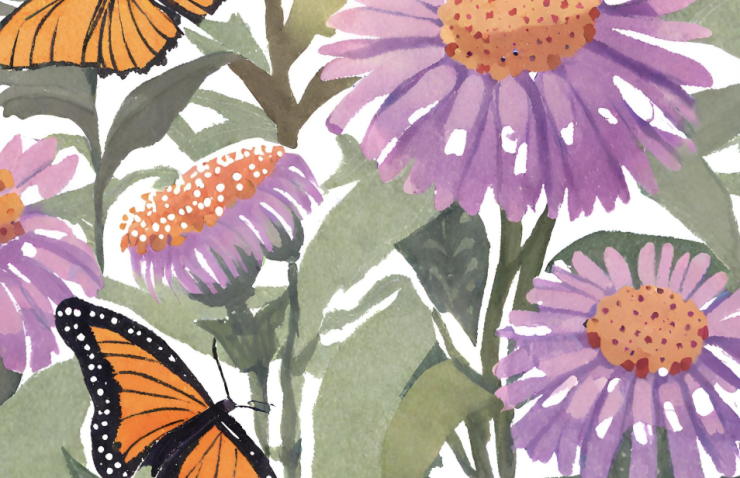

I’ve always been fascinated by the beauty and importance of butterflies in our gardens. These creatures add a touch of color and movement to our outdoor spaces and play a crucial role as pollinators in our ecosystems. Over the years, I’ve discovered that by planting the right flowers, we can create a haven for various butterfly species, providing them with the nectar, shelter, and even a place to lay their eggs. Today, I want to share with you my top 6 flowers to plant in your garden to attract a wide range of butterflies. And if you’d like to learn about more varietals, download our free Butterfly Garden Planting Chart which includes 18 more!
First on my list is the Butterfly Bush (Buddleja davidii). This deciduous shrub is an absolute must-have for any butterfly garden. With its long, arching clusters of fragrant flowers in shades of purple, pink, white, or yellow, the Butterfly Bush blooms from Summer to Fall, offering a consistent nectar source for butterflies. I’ve found that it attracts a variety of species, including the iconic Monarchs, the charming Painted Ladies, the striking Red Admirals, and the elegant Swallowtails.
Next up are Zinnias (Zinnia elegans), annual flowers that come in a dazzling array of colors, from bright yellows and oranges to vibrant pinks and reds. What I love about Zinnias is their long blooming period, which lasts from Summer until the first frost, making them a fantastic choice for a butterfly garden. In my experience, Zinnias are particularly attractive to Monarchs, Swallowtails, and Painted Ladies, who simply can’t resist their vibrant, daisy-like flowers.
Now, let’s talk about Milkweed (Asclepias spp.). This plant holds a special place in my heart, as it serves not only as a nectar source for adult butterflies but also as a host plant for Monarch caterpillars. Monarch butterflies lay their eggs exclusively on milkweed plants, making them essential for the species’ survival. There are several milkweed species to choose from, such as Common Milkweed, Swamp Milkweed, and Butterfly Weed, all of which produce clusters of small, fragrant flowers that are simply irresistible to Monarchs.
Asters (Symphyotrichum spp.) are a must-have for any butterfly enthusiast, especially as they are late-season bloomers that provide a vital nectar source for butterflies preparing to migrate or overwinter. These perennial plants produce star-shaped flowers in shades of purple, pink, and white, and I’ve found them to be particularly attractive to Pearl Crescents, American Ladies, and Silvery Checkerspots.
Phlox (Phlox spp.) is a diverse genus of plants that includes both annual and perennial species. They produce clusters of small, fragrant flowers in various colors, including pink, purple, white, and red. In my experience, Phlox is particularly attractive to Swallowtails, Sulphurs, and Hairstreak butterflies.
Last but not least, Catmint (Nepeta spp.) is a perennial plant with aromatic, gray-green foliage and spikes of small, lavender-blue flowers. It blooms from late Spring to Summer and is attractive to both butterflies and bees. Catmint is drought-tolerant and easy to grow, making it a low-maintenance addition to any butterfly garden. I’ve noticed that it’s particularly popular with Painted Ladies, Red Admirals, and Skipper butterflies.
Creating a thriving butterfly garden is all about planting a variety of these flowers in a sunny location, as butterflies prefer to feed and bask in the sun. They are drawn to flat-topped or clustered flowers that provide easy landing and nectar access. It’s crucial to avoid using pesticides in your garden, as they can harm butterflies and other beneficial insects. Instead, opt for natural pest control methods or hand-pick any pests you find.
In addition to providing nectar-rich flowers, I always make sure to offer a shallow water source for butterflies to drink from and stay hydrated. A birdbath or a shallow dish filled with pebbles and water does the trick. I also place flat stones near the water source to give butterflies a place to rest and sun themselves.
By incorporating these top 6 flowers into your garden and creating a butterfly-friendly environment, you’ll not only enjoy the beauty and grace of these enchanting creatures but also contribute to their conservation. As you watch butterflies flutter from flower to flower, you’ll be rewarded with the satisfaction of knowing that you’ve created a haven for these essential pollinators. Trust me, there’s nothing quite like the joy of seeing your garden come alive with the dance of butterflies.
And if you want to learn more, download our free Butterfly Garden Planting Chart. It’s divided into four sections, so you know which plants or flowers you can grow based on the type of soil and amount of sun your garden gets. There are two dozen gorgeously illustrated plants in it, and along with this frame-worthy illustration, you also get these plants in list form where you can discover their botanical name, how much sun and water they need, what kind of soil they prefer, and some additional interesting facts about each of them.
Start your butterfly garden today! Leave a comment with your favorite butterfly-attracting flowers!



